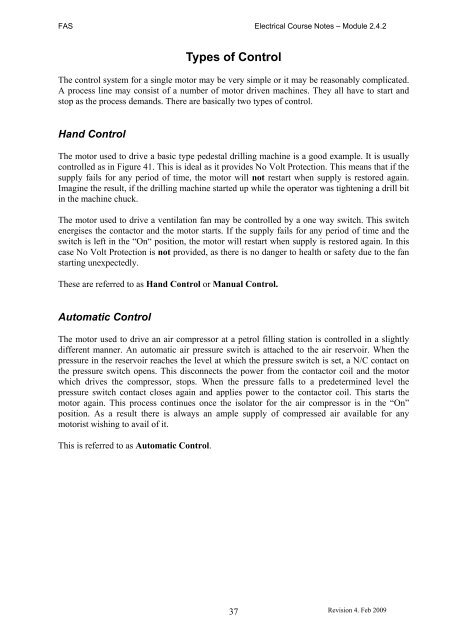Trade of Electrician Motor Control COURSE NOTES - eCollege
Trade of Electrician Motor Control COURSE NOTES - eCollege
Trade of Electrician Motor Control COURSE NOTES - eCollege
Create successful ePaper yourself
Turn your PDF publications into a flip-book with our unique Google optimized e-Paper software.
FAS Electrical Course Notes – Module 2.4.2<br />
Types <strong>of</strong> <strong>Control</strong><br />
The control system for a single motor may be very simple or it may be reasonably complicated.<br />
A process line may consist <strong>of</strong> a number <strong>of</strong> motor driven machines. They all have to start and<br />
stop as the process demands. There are basically two types <strong>of</strong> control.<br />
Hand <strong>Control</strong><br />
The motor used to drive a basic type pedestal drilling machine is a good example. It is usually<br />
controlled as in Figure 41. This is ideal as it provides No Volt Protection. This means that if the<br />
supply fails for any period <strong>of</strong> time, the motor will not restart when supply is restored again.<br />
Imagine the result, if the drilling machine started up while the operator was tightening a drill bit<br />
in the machine chuck.<br />
The motor used to drive a ventilation fan may be controlled by a one way switch. This switch<br />
energises the contactor and the motor starts. If the supply fails for any period <strong>of</strong> time and the<br />
switch is left in the “On“ position, the motor will restart when supply is restored again. In this<br />
case No Volt Protection is not provided, as there is no danger to health or safety due to the fan<br />
starting unexpectedly.<br />
These are referred to as Hand <strong>Control</strong> or Manual <strong>Control</strong>.<br />
Automatic <strong>Control</strong><br />
The motor used to drive an air compressor at a petrol filling station is controlled in a slightly<br />
different manner. An automatic air pressure switch is attached to the air reservoir. When the<br />
pressure in the reservoir reaches the level at which the pressure switch is set, a N/C contact on<br />
the pressure switch opens. This disconnects the power from the contactor coil and the motor<br />
which drives the compressor, stops. When the pressure falls to a predetermined level the<br />
pressure switch contact closes again and applies power to the contactor coil. This starts the<br />
motor again. This process continues once the isolator for the air compressor is in the “On”<br />
position. As a result there is always an ample supply <strong>of</strong> compressed air available for any<br />
motorist wishing to avail <strong>of</strong> it.<br />
This is referred to as Automatic <strong>Control</strong>.<br />
37<br />
Revision 4. Feb 2009

















